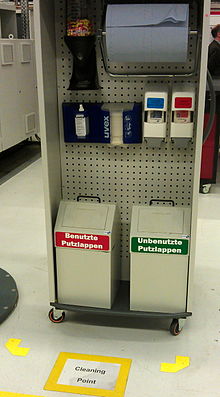5S
The 5S - Work Design , also in the German-speaking 5A called, is a mainly engaged in production industry and increasingly applied in services methodology, where the term is precisely defined measures. It is an idea from the Japanese Toyota production system . 5S serves as an instrument to make workplaces and their surroundings safe, clean and clear. Order and cleanliness are basic prerequisites for improving the work processes that run on them. It is believed that this will also reduce the risk of occupational accidents .
The aim of a 5S program is to design workplaces in such a way that work can run smoothly, searches, long transport routes and waiting times can be avoided and work can thus be carried out without waste. A clean and tidy work environment is also the basis for quality work.
As a methodical tool, 5S can be used in all areas of an organization, in production as well as in services and administration through to data storage and IT. The direct involvement of the employees concerned ( employee participation ) makes it easier to find weak points and implement improvements. An essential principle of the method is to make the developed standards visible at the workplaces. In this way, deviations can be recognized more quickly by outsiders and superiors.
In German, efforts are usually made to find translations that retain the first letter "S" of the original Japanese names. There are different versions in circulation.
The "5S" can be translated into German with:
- Seiri
- Sort out. Everything that is not needed for the work in this place is sorted out.
- Seiton
- Place neatly. What is actually needed is given a fixed place that has been selected, defined and marked from an ergonomic point of view.
- Seiso
- Clean up. Everyone cleans their workplace and their work utensils themselves. Defects are recognized, marked and constantly processed. The cleaning is used for testing.
- Seiketsu
- Standardize. This means the use of uniform markings, labels and markings throughout the workplace at all times. Constant tidying up prevents new items from finding unplanned access to the workplace.
- Shitsuke
- Self-discipline and constant improvement ( Kaizen ). Discipline is required to maintain order and cleanliness. If a space has been defined for a tool, it always belongs there. Regular controls are carried out and deviations are noted. Any discrepancies found must be eliminated.
5A
Some transcriptions go for the "A". That is why the concept is also known as "5A". One way of writing the 5A method is:
- Sort out
- Tidying up (arrange work equipment ergonomically)
- Workplace cleanliness
- Make arrangement the rule
- Adhere to and improve all points
literature
- Frank Thieme, Gero Panskus: The German 5S workbook: the application of the 5S methodology in networked performance management in the factory and office. Wuppertal: Panskus Performance Development 2008, ISBN 3-9807276-8-8 .
- Hiroyuki Hirano, Melanie Rubin (Eds.): 5s for operators: 5 pillars of the visual workplace. New York, Productivity Press 2007, ISBN 978-1-56327-123-6 .
- Debashis Sarkar: 5S for service organizations and offices: a lean look at improvements. Milwaukee, ASQ Quality Press 2006, ISBN 0-87389-677-7 .
- Thomas L. Jackson: 5S for healthcare. Boca Raton, CRC Press 2009, ISBN 978-1-4398-0350-9 .
- Tom Fabrizio, Don Tapping: 5 S for the office: organizing the workplace to eliminate waste. New York, Productivity Press 2008, ISBN 1-56327-318-7 .
Individual evidence
- ↑ Carsten-Klages: Glossary for synchronous production. (PDF; 899 kB) Version 1.7. (No longer available online.) In: www.awf.de. February 24, 2009, archived from the original on May 24, 2015 ; Retrieved July 5, 2013 .
- ^ Müller, Alois: 5S workplace organization. Online: Background of 5S workplace organization , read on: 09-05-26.


